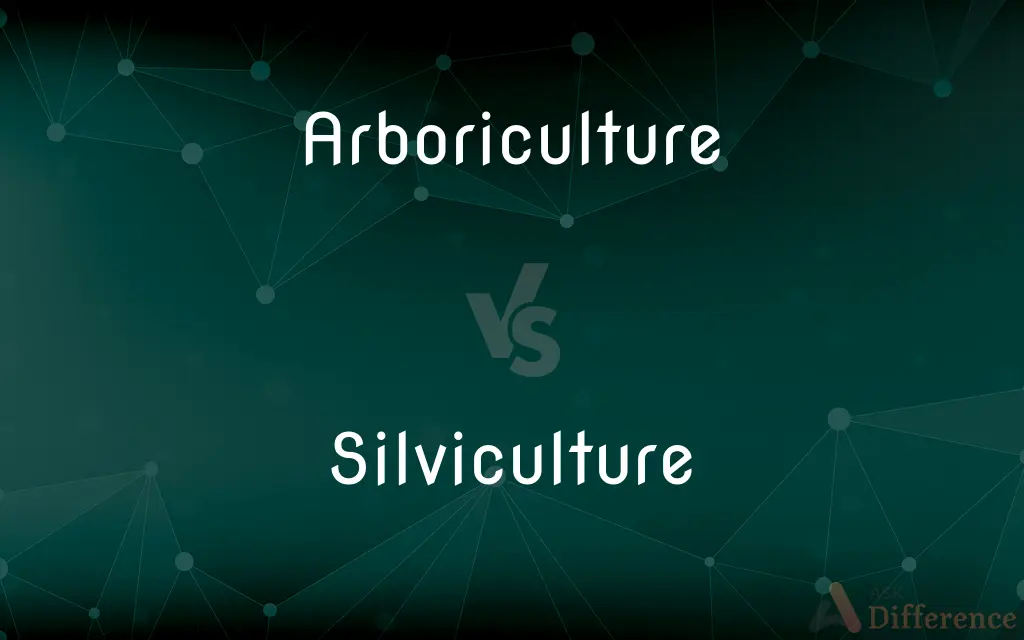Arboriculture vs. Silviculture — What's the Difference?
By Tayyaba Rehman & Fiza Rafique — Updated on March 26, 2024
Arboriculture is the cultivation and management of individual trees and shrubs, focusing on care within urban settings. Silviculture is the practice of managing forests and woodlands for timber production and ecological sustainability.

Difference Between Arboriculture and Silviculture
Table of Contents
ADVERTISEMENT
Key Differences
Arboriculture primarily deals with the care and maintenance of individual trees, often in urban or landscaped environments. It includes planting, pruning, disease management, and removal. Whereas silviculture is concerned with the establishment, growth, composition, and health of forests, aiming to fulfill various forestry objectives, including timber production, recreation, and conservation.
Arboriculturists are specialists who focus on the health and safety of individual trees and shrubs, applying their knowledge to ensure proper placement, care, and risk management. On the other hand, silviculturists work on a larger scale, planning and implementing practices that affect whole forests, such as thinning, harvesting, and regeneration strategies to ensure forest sustainability and health.
The practice of arboriculture is often seen in cities, parks, and gardens, where the health and appearance of trees directly impact human environments and property values. Whereas silviculture is practiced in rural forested areas, focusing on managing forest resources for economic, recreational, and ecological benefits, including biodiversity conservation.
Arboriculture involves detailed knowledge of tree physiology, pathology, and individual species requirements to address specific issues such as pest infestations or environmental stressors. While silviculture requires an understanding of forest ecology, including the interactions between different plant species, wildlife, and environmental factors, to manage forests sustainably over large areas.
Arboriculture and silviculture share common goals of health and vitality for trees, but their approaches and scales differ significantly. Arboriculture focuses on the individual or small groups of trees, emphasizing aesthetic and safety considerations. Silviculture, on the other hand, applies a broader perspective, managing forests for multiple uses and long-term ecological balance.
ADVERTISEMENT
Comparison Chart
Definition
The care and management of individual trees and shrubs.
The science and art of managing forests and woodlands.
Scale
Individual trees or small groups.
Large forests and woodlands.
Focus
Health, safety, and aesthetics of trees.
Timber production, ecological sustainability, and conservation.
Practiced in
Urban areas, parks, and gardens.
Rural and forested areas.
Key Activities
Planting, pruning, disease management, removal.
Thinning, harvesting, reforestation, managing forest health.
Compare with Definitions
Arboriculture
Involves detailed knowledge of tree physiology and pathology to care for trees.
Arboriculture experts diagnosed the disease affecting the elm trees and treated them accordingly.
Silviculture
The art and science of controlling the establishment, growth, composition, and quality of forests.
Silviculture techniques were used to ensure the forest's sustainability and biodiversity.
Arboriculture
The practice of cultivating and managing individual trees, primarily in urban or landscaped settings.
Arboriculture involves regular tree assessments to identify potential hazards in public parks.
Silviculture
Aims at sustainable forest management to meet diverse objectives, including ecological balance.
The national park's silviculture program focused on preserving old-growth forests while allowing for recreational use.
Arboriculture
Focused on the health and safety of single trees and shrubs, including pruning and disease treatment.
The city's arboriculture team implemented a pruning schedule to maintain tree health and aesthetics.
Silviculture
Involves practices such as thinning, clear-cutting, and controlled burns to manage forest health.
Silviculturists implemented thinning operations to reduce fire risk and improve forest health.
Arboriculture
Emphasizes the aesthetic and functional aspects of trees in the landscape.
Arboriculture practices have significantly improved the visual appeal of our urban green spaces.
Silviculture
Requires understanding of forest ecology and the long-term planning of forest landscapes.
Silviculture practices were adjusted based on long-term climate change predictions to ensure forest resilience.
Arboriculture
Deals with the selection, planting, and maintenance of trees in designed landscapes.
Through arboriculture, the new housing development included a variety of trees that would thrive in the area.
Silviculture
Focuses on managing forests for timber production, conservation, and recreation.
The silviculture plan included areas for logging, wildlife habitats, and hiking trails.
Arboriculture
Arboriculture () is the cultivation, management, and study of individual trees, shrubs, vines, and other perennial woody plants. The science of arboriculture studies how these plants grow and respond to cultural practices and to their environment.
Silviculture
Silviculture is the practice of controlling the growth, composition/structure, and quality of forests to meet values and needs, specifically timber production. The name comes from the Latin silvi- ('forest') and culture ('growing').
Arboriculture
The planting and care of woody plants, especially trees.
Silviculture
The care and cultivation of forest trees; forestry.
Arboriculture
The branch of horticulture concerned with the planting, growth, and maintenance of trees.
Silviculture
The care and development of forests in order to obtain a product or provide a benefit; forestry.
Arboriculture
The cultivation of trees and shrubs, chiefly for timber or for ornamental purposes.
Silviculture
See Sylviculture.
Arboriculture
The cultivation of tree for the production of timber
Silviculture
The branch of forestry dealing with the development and care of forests
Common Curiosities
How do arboriculture and silviculture differ?
The main difference lies in their scale and focus: arboriculture deals with individual trees or small groups, often in urban environments, focusing on tree health and aesthetics, while silviculture manages entire forests or woodlands, focusing on broader objectives like timber production and ecological sustainability.
How does silviculture contribute to forest conservation?
Silviculture contributes to forest conservation by applying scientific and management principles to maintain and enhance forest biodiversity, productivity, regeneration capacity, vitality, and their potential to fulfill relevant ecological, economic, and social functions.
What skills are necessary for a career in arboriculture?
A career in arboriculture requires knowledge of tree physiology and pathology, practical skills in tree care techniques, and an understanding of safety regulations related to tree work.
What is silviculture?
Silviculture is the practice of managing the growth, composition, health, and quality of forests to meet diverse needs and values, including timber production and environmental conservation.
Are there certifications available for arboriculture professionals?
Yes, certifications such as the Certified Arborist designation from the International Society of Arboriculture (ISA) are available for professionals to demonstrate their knowledge and commitment to best practices in arboriculture.
What is arboriculture?
Arboriculture is the cultivation, management, and study of individual trees, shrubs, vines, and other perennial woody plants, mainly in urban settings.
Can arboriculture and silviculture overlap?
Yes, they can overlap in practices aimed at tree health and sustainable management, especially in urban forestry where the goals of tree care and ecosystem management intersect.
Why is arboriculture important in urban areas?
Arboriculture is crucial in urban areas for maintaining the health and safety of trees that impact air quality, provide shade, and enhance the aesthetic value of landscapes, contributing to the overall quality of life.
Is arboriculture only concerned with trees in urban areas?
While arboriculture focuses heavily on trees in urban and landscaped settings, it also applies to rural areas where individual tree care and management are needed outside of forests.
What are some common tools used in arboriculture?
Common tools in arboriculture include chainsaws, pruning shears, ladders, and safety harnesses for tree climbing, as well as specialized equipment for tree health assessment.
What role does arboriculture play in climate change mitigation?
Arboriculture plays a significant role in climate change mitigation by maintaining and increasing urban tree cover, which helps sequester carbon, reduce urban heat island effects, and improve air quality.
What is the future outlook for careers in arboriculture and silviculture?
The future outlook for careers in arboriculture and silviculture is positive, driven by the increasing recognition of the importance of trees and forests in urban planning, climate change mitigation, and conservation efforts.
What challenges do arboriculturists face in their work?
Arboriculturists face challenges such as dealing with tree diseases and pests, navigating local regulations and public concerns, and ensuring safety in high-risk activities like tree climbing and removal.
What skills are necessary for a career in silviculture?
A career in silviculture requires a deep understanding of forest ecology and management, skills in planning and implementing forest management practices, and the ability to balance economic production with environmental conservation.
How does climate change affect silviculture strategies?
Climate change affects silviculture strategies by necessitating adjustments in management practices to accommodate shifting temperature and precipitation patterns, ensuring forest resilience and adaptability.
How is silviculture adapted to different types of forests?
Silviculture is adapted to different types of forests by employing specific practices that align with the ecological characteristics and management objectives of each forest type, such as deciduous vs. coniferous forests.
How does urban expansion impact the field of arboriculture?
Urban expansion impacts the field of arboriculture by increasing the demand for tree care services to manage the health and safety of trees in growing cities, as well as for planning and planting new green spaces.
Can silviculture practices impact wildlife?
Yes, silviculture practices can significantly impact wildlife by altering habitat structures, food availability, and the overall ecological balance of forested areas.
How do silviculture and arboriculture contribute to sustainable development?
Both disciplines contribute to sustainable development by promoting the sustainable management and use of tree resources, enhancing biodiversity, and providing ecosystem services that support social, economic, and environmental goals.
Share Your Discovery

Previous Comparison
Heavily vs. Strongly
Next Comparison
Bulkhead vs. ParapetAuthor Spotlight
Written by
Tayyaba RehmanTayyaba Rehman is a distinguished writer, currently serving as a primary contributor to askdifference.com. As a researcher in semantics and etymology, Tayyaba's passion for the complexity of languages and their distinctions has found a perfect home on the platform. Tayyaba delves into the intricacies of language, distinguishing between commonly confused words and phrases, thereby providing clarity for readers worldwide.
Co-written by
Fiza RafiqueFiza Rafique is a skilled content writer at AskDifference.com, where she meticulously refines and enhances written pieces. Drawing from her vast editorial expertise, Fiza ensures clarity, accuracy, and precision in every article. Passionate about language, she continually seeks to elevate the quality of content for readers worldwide.














































